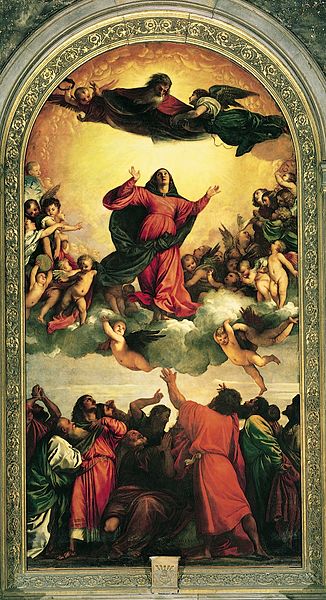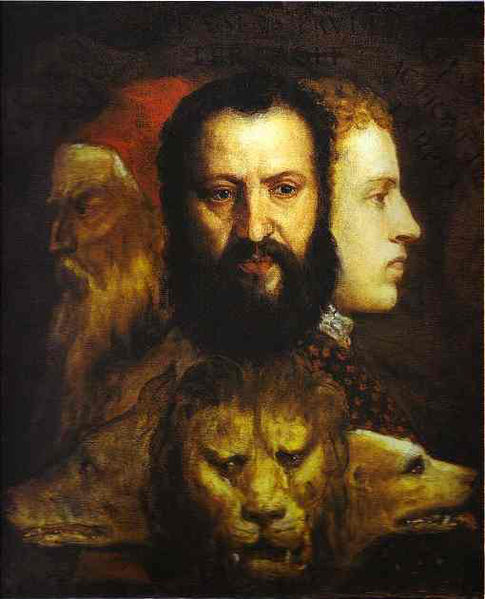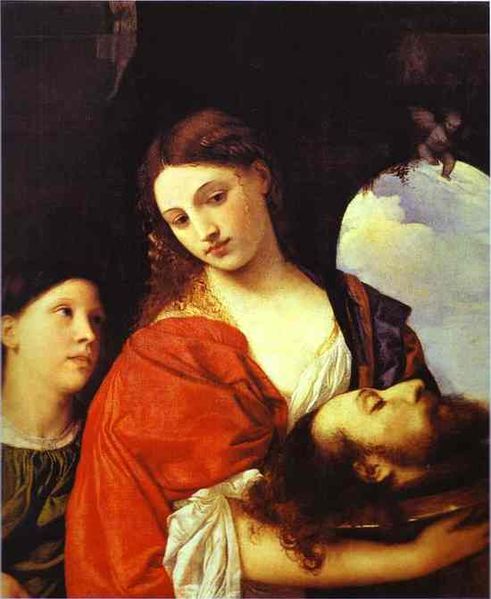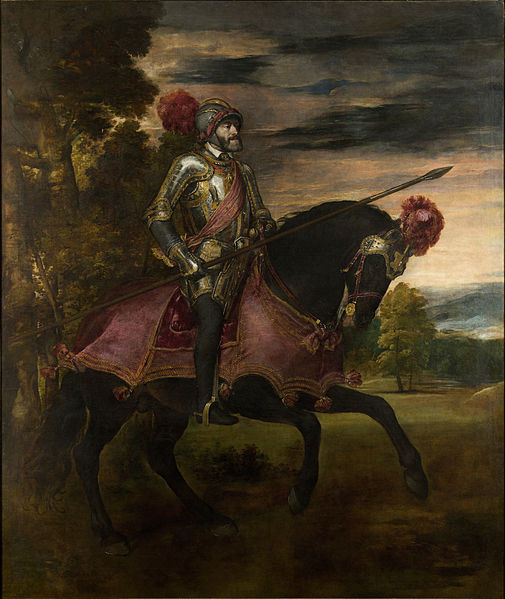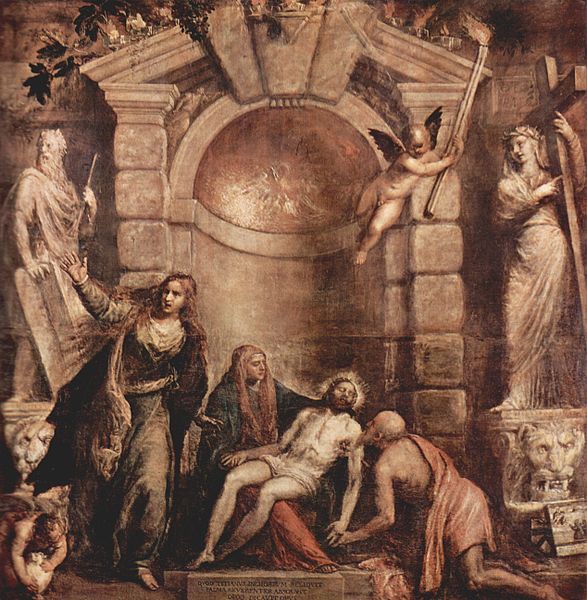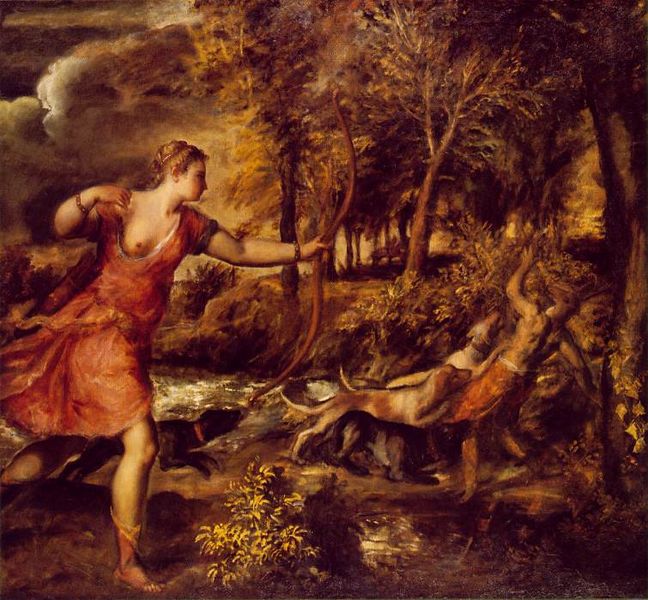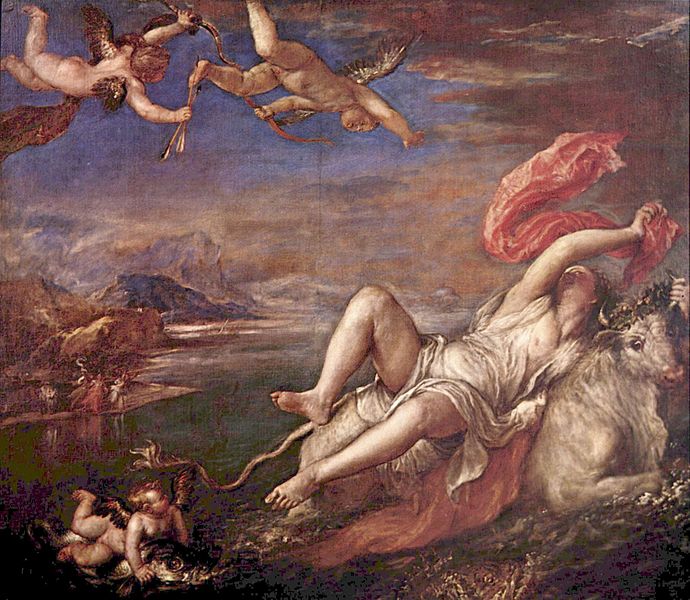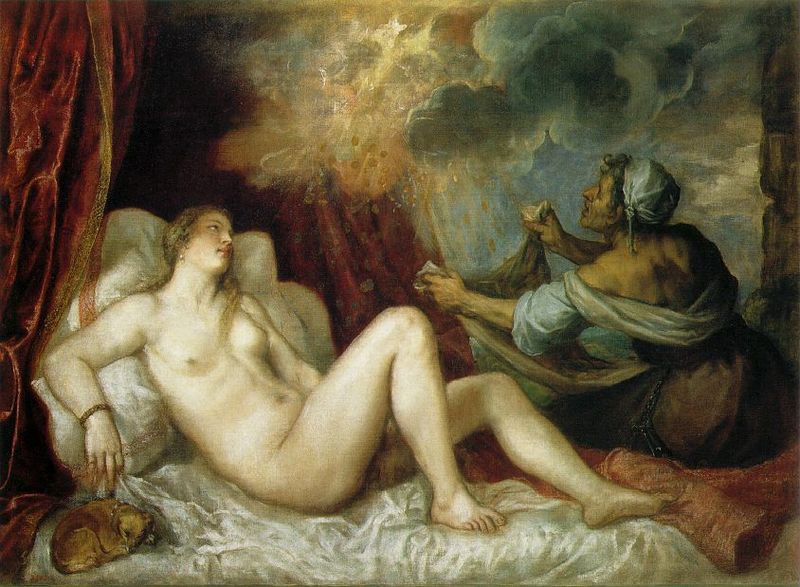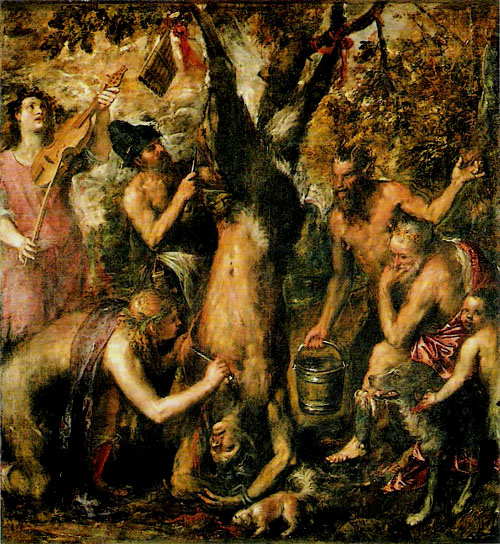<Back to Index>
- Computer Scientist Kristen Nygaard, 1926
- Painter Tiziano Vecelli (Titian), 1488
- Duke of Parma and Piacenza Alessandro Farnese, 1545
PAGE SPONSOR
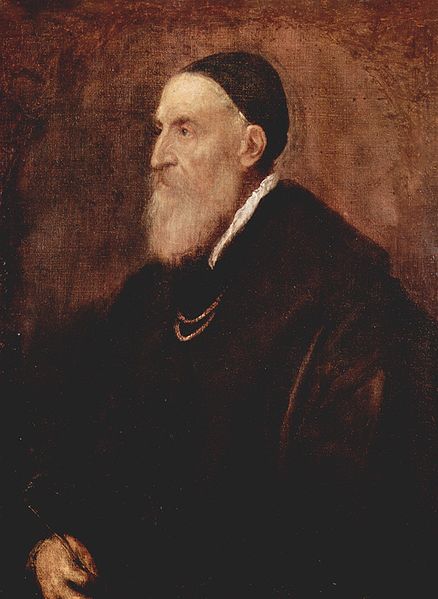
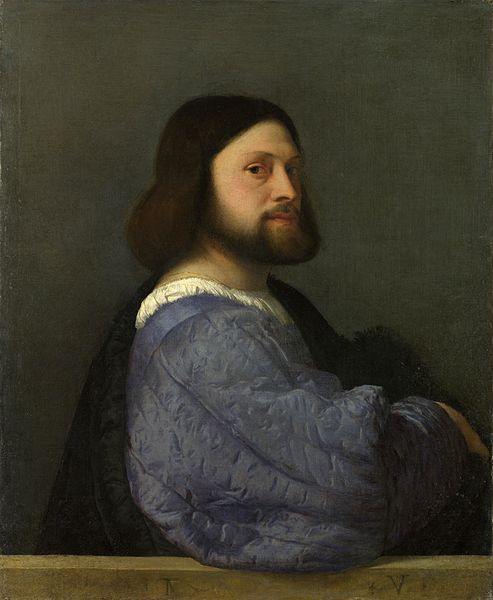
Tiziano Vecelli or Tiziano Vecellio (c. 1488/1490 – 27 August 1576, better known asTitian) was an Italian painter, the most important member of the 16th century Venetian school. He was born in Pieve di Cadore, near Belluno (in Veneto), in the Republic of Venice. During his lifetime he was often called da Cadore, taken from the place of his birth.
Recognized by his contemporaries as "The Sun Amidst Small Stars" (recalling the famous final line of Dante's Paradiso), Titian was one of the most versatile of Italian painters, equally adept with portraits, landscape backgrounds, and mythological and religious subjects. His painting methods, particularly in the application and use of color, would exercise a profound influence not only on painters of the Italian Renaissance, but on future generations of Western art.
During the course of his long life, Titian's artistic manner changed drastically but he retained a lifelong interest in color. Although his mature works may not contain the vivid, luminous tints of his early pieces, their loose brushwork and subtlety of polychromatic modulations are without precedent in the history of Western art.
The exact date of Titian's birth is uncertain; when he was an old man he claimed in a letter to Philip II to have been born in 1474, but this seems most unlikely. Other writers contemporary to his old age give figures which would equate to birthdates between 1473 to after 1482, but most modern scholars believe a date nearer 1490 is more likely; the Metropolitan Museum of Art's timeline supports c. 1488, as does the Getty Research Institute. He
was the eldest son of Gregorio Vecelli and his wife Lucia. His father
was superintendent of the castle of Pieve di Cadore and managed local
mines for their owners. Gregorio was also a distinguished councilor and soldier. Many relatives, including Titian's grandfather, were notaries, and the family of four were well established in the area, which was ruled by Venice. At
the age of about ten to twelve he and his brother Francesco (who
perhaps followed later) were sent to an uncle in Venice to find an
apprenticeship with a painter. The minor painter Sebastian Zuccato,
whose sons became well known mosaicists, and who may have been a family friend, arranged for the brothers to enter the studio of the elderly Gentile Bellini, from which they later transferred to that of his brother Giovanni Bellini. At
that time the Bellinis, especially Giovanni, were the leading artists
in the city. There Titian found a group of young men about his own age,
among them Giovanni Palma da Serinalta, Lorenzo Lotto, Sebastiano Luciani, and Giorgio da Castelfranco, nicknamed Giorgione. Francesco Vecellio, his older brother, later became a painter of some note in Venice. A fresco of Hercules on the Morosini Palace is said to have been one of Titian's earliest works; others were the Bellini - esque so - called Gypsy Madonna in Vienna, and the Visitation of Mary and Elizabeth (from the convent of S. Andrea), now in the Accademia, Venice. Titian
joined Giorgione as an assistant, but many contemporary critics already
found his work more impressive, for example in the exterior frescoes
(now almost totally destroyed) that they did for the Fondaco dei Tedeschi (state - warehouse
for the German merchants), and their relationship evidently had a
significant element of rivalry. Distinguishing between their work at
this period remains a subject of scholarly controversy, and there has
been a substantial movement of attributions from Giorgione to Titian in
the 20th century, with little traffic the other way. One of the earliest
known works of Titian, Christ Carrying the Cross in the Scuola Grande di San Rocco, depicting the Ecce Homo scene, was long regarded as the work of Giorgione. The two young masters were likewise recognized as the two leaders of their new school of arte moderna,
which is characterized by paintings made more flexible, freed from
symmetry and the remnants of hieratic conventions still to be found in
the works of Giovanni Bellini. In 1507 – 1508 Giorgione was commissioned by the state to create frescoes on the re-erected Fondaco dei Tedeschi. Titian and Morto da Feltre worked
along with him, and some fragments of paintings remain, probably by
Giorgione. Some of their work is known, in part, through the engravings
of Fontana.
After Giorgione's early death in 1510, Titian continued to paint
Giorgionesque subjects for some time, though his style developed its own
features, including bold and expressive brushwork. Titian's talent in fresco is shown in those he painted in 1511 at Padua in the Carmelite church and in the Scuola del Santo, some of which have been preserved, among them the Meeting at the Golden Gate, and three scenes (Miracoli di sant' Antonio) from the life of St. Anthony of Padua, The Miracle of the Jealous Husband which depicts the Murder of a Young Woman by Her Husband, A Child Testifying to Its Mother's Innocence, and The Saint Healing the Young Man with a Broken Limb. From Padua in 1512, Titian returned to Venice; and in 1513 he obtained a broker's patent, termed La Sanseria or Senseria (a
privilege much coveted by rising or risen artists), in the Fondaco dei
Tedeschi and became superintendent of the government works, being
especially charged to complete the paintings left unfinished by
Giovanni Bellini in the hall of the great council in the ducal palace. He set up an atelier on the Grand Canal at
S. Samuele, the precise site being now unknown. It was not until 1516,
after the death of Giovanni Bellini, that he came into actual enjoyment
of his patent. At the same time he entered an exclusive arrangement for
painting. The patent yielded him a good annuity of 20 crowns and
exempted him from certain taxes — he being bound in return to paint
likenesses of the successive Doges of his time at the fixed price of eight crowns each. The actual number he painted was five. During this period (1516 – 1530), which may be called the period of his mastery and maturity, the artist moved on from his early Giorgionesque style,
undertook larger and more complex subjects and for the first time
attempted a monumental style. Giorgione died in 1510 and Giovanni
Bellini in 1516, leaving Titian unrivaled in the Venetian School. For
sixty years he was to be the undisputed master of Venetian painting. In
1516 he completed for the high altar of the church of the Frari, his famous masterpiece, the Assumption of the Virgin,
still in situ. This extraordinary piece of colorism, executed on a
grand scale rarely before seen in Italy, created a sensation. The Signoria took
note, and observed that Titian was neglecting his work in the hall of
the great council, but in 1516 he succeeded his master Giovanni Bellini
in receiving a pension from the Senate. The pictorial structure of the Assumption — that
of uniting in the same composition two or three scenes superimposed on
different levels, earth and heaven, the temporal and the infinite — was
continued in a series of works such as the retable of San Domenico at Ancona (1520), the retable of Brescia (1522), and the retable of San Niccolò (1523), in the Vatican Museum, each time attaining to a higher and more perfect conception, finally reaching a classic formula in the Pesaro Madonna,
(better known as the Madonna di Ca' Pesaro) (c. 1519 – 1526), also for
the Frari church. This perhaps is his most studied work, whose patiently
developed plan is set forth with supreme display of order and freedom,
originality and style. Here Titian gave a new conception of the
traditional groups of donors and holy persons moving in aerial space,
the plans and different degrees set in an architectural framework. Titian
was now at the height of his fame, and towards 1521, following the
production of a figure of St. Sebastian for the papal legate in Brescia
(a work of which there are numerous replicas), purchasers pressed for
his work. To this period belongs a more extraordinary work, The Death of St. Peter Martyr (1530), formerly in the Dominican Church of San Zanipolo, and destroyed by an Austrian shell in 1867. Only copies and engravings of this proto - Baroque picture
remain; it combined extreme violence and a landscape, mostly consisting
of a great tree, that pressed into the scene and seems to accentuate the drama in a way that looks forward to the Baroque. The artist simultaneously continued his series of small Madonnas which he treated amid beautiful landscapes in the manner of genre pictures or poetic pastorals, the Virgin with the Rabbit in the Louvre being the finished type of these pictures. Another work of the same period, also in the Louvre, is the Entombment. This was also the period of the three large and famous mythological scenes for the camerino of Alfonso d'Este in Ferrara, The Andrians and the Worship of Venus in the Prado, and the Bacchus and Ariadne (1520 – 23) in London, "...perhaps
the most brilliant productions of the neo-pagan culture or
"Alexandrianism" of the Renaissance, many times imitated but never
surpassed even by Rubens himself." Finally this was the period when the artist composed the half - length figures and busts of young women, probably courtesans, such as Flora of the Uffizi, or Woman at the Mirror in the Louvre. Titian's
wife, Cecilia — a barber's daughter from his hometown village of
Cadore — was a young woman who had been his housekeeper and mistress for
some five years. Cecilia had already borne Titian two fine sons,
Pomponio and Orazio, when in 1525 she fell seriously ill. Titian,
wishing to legitimize the children, married her. The marriage was a
happy one and Cecilia recovered and bore him two more children, both
daughters. Only one of them, Lavinia, survived. Titian's favorite child
was Orazio, who became his assistant. In
August 1530 his wife died giving birth to daughter Lavinia, and with
his two boys plus infant girl he moved house, and convinced his sister
Orsa to come from Cadore and take charge of the household. The mansion,
difficult to find now, is in the Biri Grande, then a fashionable suburb,
at the extreme end of Venice, on the sea, with beautiful gardens and a
view towards Murano. In about 1526 he had became acquainted, and soon
intimate, with Pietro Aretino,
the influential and audacious figure who features so strangely in the
chronicles of the time. Titian sent a portrait of him to Gonzaga, duke
of Mantua.
During the next period (1530 – 1550), Titian developed the style introduced by his dramatic Death of St. Peter Martyr.
The Venetian government, dissatisfied with Titian's neglect of the work
for the ducal palace, ordered him in 1538 to refund the money which he
had received, and Pordenone,
his rival of recent years, was installed in his place. However, at the
end of a year Pordenone died, and Titian, who meanwhile applied himself
diligently to painting in the hall the Battle of Cadore,
was reinstated. This major battle scene was lost along with so many
other major works by Venetian artists by the great fire which destroyed
all the old pictures in the great chambers of the Doge's Palace in 1577.
It represented in life - size the moment at which the Venetian general, D'Alviano attacked
the enemy with horses and men crashing down into a stream, and was the
artist's most important attempt at a tumultuous and heroic scene of
movement to rival Raphael's Battle of Constantine and the equally ill - fated Battle of Cascina of Michelangelo and The Battle of Anghiari of Leonardo (both unfinished). There remains only a poor, incomplete copy at the Uffizi, and a mediocre engraving by Fontana. The Speech of the Marquis del Vasto (Madrid, 1541) was also partly destroyed by fire. But this period of the master's work is still represented by the Presentation of the Blessed Virgin (Venice, 1539), one of his most popular canvasses, and by the Ecce Homo (Vienna, 1541). Despite its loss, the painting had a great influence on Bolognese art and Rubens,
both in the handling of details and the general effect of horses,
soldiers, lictors, powerful stirrings of crowds at the foot of a
stairway, lit by torches with the flapping of banners against the sky. Less successful were the pendentives of the cupola at Santa Maria della Salute (Death of Abel, Sacrifice of Abraham, David and Goliath). These violent scenes viewed in perspective from below — like the famous pendentives of the Sistine Chapel Ceiling — were by their very nature in unfavorable situations. They were nevertheless
much admired and imitated, Rubens among others applying this system to
his forty ceilings (the sketches only remain) of the Jesuit church at Antwerp. At this time also, during his visit to Rome, the artist began his series of reclining Venuses (TheVenus of Urbino of the Uffizi, Venus and Love at the same museum, Venus and the Organ - Player,
Madrid), in which is recognized the effect or the direct reflection of
the impression produced on the master by contact with ancient sculpture. Giorgione had
already dealt with the subject in his Dresden picture, finished by
Titian, but here a purple drapery substituted for a landscape background
changed, by its harmonious coloring, the whole meaning of the scene. Titian had from the beginning of his career shown himself to be a masterful portrait painter, in works like La Bella (Eleanora
de Gonzaga, Duchess of Urbino, at the Pitti Palace). He painted the
likenesses of princes, or Doges, cardinals or monks, and artists or
writers. "...no other painter was so successful in extracting from each
physiognomy so many traits at once characteristic and beautiful",
according to The Catholic Encyclopedia. Among portrait painters Titian is compared to Rembrandt and Velázquez, with the interior life of the former, and the clearness, certainty, and obviousness of the latter. The last - named qualities are sufficiently manifested in the Portrait of Paul III of Naples, or the sketch of the same pope and his two nephews, the Portrait of Aretino of the Pitti Palace, the Eleanora of Portugal (Madrid), and the series of Emperor Charles V of the same museum, the Charles V with a Greyhound (1533), and especially the Equestrian Portrait of Charles V (1548), an equestrian picture which as a symphony of purples is perhaps the ne plus ultra of
the art of painting. In 1532 after painting a portrait of the emperor
Charles V in Bologna he was made a Count Palatine and knight of the
Golden Spur. His children were also made nobles of the Empire, which for
a painter was an exceptional honor. As a matter of professional and worldly success his position from about this time is regarded as equal only to that of Raphael, Michelangelo, and at a later date Rubens.
In 1540 he received a pension from D'Avalos, marquis del Vasto, and an
annuity of 200 crowns (which was afterwards doubled) from Charles V from
the treasury of Milan.
Another source of profit, for he was always aware of money, was a
contract obtained in 1542 for supplying grain to Cadore, where he
visited almost every year and where he was both generous and
influential. Titian had a favorite villa on the neighboring Manza Hill (in front of the church of Castello Roganzuolo)
from which (it may be inferred) he made his chief observations of
landscape form and effect. The so-called Titian's mill, constantly
discernible in his studies, is at Collontola, near Belluno. He visited Rome in 1546, and obtained the freedom of the city — his immediate predecessor in that honor having been Michelangelo in 1537. He could at the same time have succeeded the painter Sebastiano del Piombo in his lucrative office as holder of the piombo or Papal seal, and he was prepared to take holy orders for the purpose; but the project lapsed through his being summoned away from Venice in 1547 to paint Charles V and others in Augsburg. He was there again in 1550, and executed the portrait of Philip II which was sent to England and proved useful in Philip's suit for the hand of Queen Mary. During
the last twenty - six years of his life (1550 – 1576) the artist worked
mainly for Philip II and as a portrait painter. He became more self -
critical, an insatiable perfectionist, keeping some pictures in his
studio for ten years, never wearying of returning to them and
retouching them, constantly adding new expressions at once more
refined, concise, and subtle. He also finished off many copies of
earlier works of his by his pupils, giving rise to many problems of
attribution and priority among versions of his works, which were also
very widely copied and faked outside his studio, during his lifetime
and afterwards. For Philip II he painted a series of large mythological paintings known as the "poesie", mostly from Ovid, which are regarded as among his greatest works. Thanks
to the prudishness of Philip's successors, these were later mostly
given as gifts and only two remain in the Prado. Titian was producing
religious works for Philip at the same time. The "poesie" series began
with Venus and Adonis, of which the original is in the Prado, but several versions exist, and Danaë, both sent to Philip in 1553. Diana and Actaeon and Diana and Callisto, were despatched in 1559, then Perseus and Andromeda (Wallace Collection, now damaged) and the Rape of Europa (Boston, Isabella Stewart Gardner Museum), delivered in 1562. The Death of Actaeon was begun in 1559 but worked on for many years, and never completed or delivered. Another
painting that apparently remained in his studio at his death, and has
been much less well known until recent decades, is the powerful, even
"repellant", Flaying of Marsyas (Kroměříž, Czech Republic). Another violent masterpiece is the Tarquin and Lucretia (Cambridge, Fitzwilliam Museum). For
each of the problems which he successively undertook he furnished a new
and more perfect formula. He never again equaled the emotion and
tragedy of the The Crowning with Thorns (Louvre), in the expression of the mysterious and the divine he never equaled the poetry of the Pilgrims of Emmaus, while in superb and heroic brilliancy he never again executed anything more grand than The Doge Grimani adoring Faith (Venice, Doge's Palace), or the Trinity,
of Madrid. On the other hand from the standpoint of flesh tints, his
most moving pictures are those of his old age, such as the poesie and the Antiope of the Louvre. He even attempted problems of chiaroscuro in fantastic night effects (Martyrdom of St. Laurence, Church of the Jesuits, Venice; St. Jerome, Louvre; Crucifixion, Church of San Domenico, Ancona). Titian
had engaged his daughter Lavinia, the beautiful girl whom he loved
deeply and painted various times, to Cornelio Sarcinelli of Serravalle.
She had succeeded her aunt Orsa, then deceased, as the manager of the
household, which, with the lordly income that Titian made by this time,
placed her on a corresponding footing. The marriage took place in 1554.
She died in childbirth in 1560. He was at the Council of Trent towards
1555, of which there is a finished sketch in the Louvre. Titian's
friend Aretino died suddenly in 1556, and another close intimate, the
sculptor and architect Jacopo Sansovino,
in 1570. In September 1565 Titian went to Cadore and designed the
decorations for the church at Pieve, partly executed by his pupils. One
of these is a Transfiguration, another an Annunciation (now in S. Salvatore, Venice), inscribed Titianus fecit, by way of protest (it is said) against the disparagement of some persons who caviled at the veteran's failing handicraft. Around 1560 Titian painted the oil on canvas Sacra Conversazione: The Madonna and Child with Saints Luke and Catherine of Alexandria, a derivative on the motif of Madonna and Child.
It is suggested that members of Titian's Venice workshop probably
painted the curtain and Luke, because of the lower quality of those
parts. He
continued to accept commissions to the end of his life. He had selected
as the place for his burial the chapel of the Crucifix in the Santa Maria Gloriosa dei Frari, the church of the Franciscan Order; in return for a grave, he offered the Franciscans a picture of the Pietà,
representing himself and his son Orazio before the Savior, another
figure in the composition being a sibyl. This work he nearly finished,
but some differences arose regarding it, and he then settled to be
interred in his native Pieve. Titian was probably in his late eighties when the plague raging
in Venice took him on 27 August 1576. He was the only victim of the
Venice plague to be given a church burial. He was interred in the Frari (Santa Maria Gloriosa dei Frari), as at first intended, and his Pietà was finished by Palma the Younger.
He lies near his own famous painting, the Madonna di Ca' Pesaro. No
memorial marked his grave, until much later the Austrian rulers of
Venice commissioned Canova to provide the large monument. Immediately
after Titian's own death, his son and assistant Orazio died of the same
epidemic. His sumptuous mansion was plundered during the plague by
thieves.
Titian himself never attempted engraving, but he was very conscious of the importance of printmaking as a means of further expanding his reputation. In the period 1517 – 1520 he designed a number of woodcuts, including an enormous and impressive one of The Crossing of the Red Sea, and collaborated with Domenico Campagnola and others, who produced further prints based on his paintings and drawings. Much later he provided drawings based on his paintings to Cornelius Cort from the Netherlands who engraved them. Martino Rota followed Cort from about 1558 to 1568. Several other artists of the Vecelli family followed in the wake of Titian. Francesco Vecellio,
his elder brother, was introduced to painting by Titian (it is said at
the age of twelve, but chronology will hardly admit of this), and
painted in the church of S. Vito in Cadore a picture of the titular
saint armed. This was a noteworthy performance, of which Titian (the
usual story) became jealous; so Francesco was diverted from painting to
soldiering, and afterwards to mercantile life. Marco Vecellio, called Marco di Tiziano,
Titian's nephew, born in 1545, was constantly with the master in his
old age, and learned his methods of work. He has left some able
productions in the ducal palace, the Meeting of Charles V. and Clement VII. in 1529 ; in S. Giacomo di Rialto, an Annunciation ; in SS. Giovani e Paolo, Christ Fulminant. A son of Marco, named Tiziano (or Tizianello), painted early in the 17th century. From a different branch of the family came Fabrizio di Ettore, a painter who died in 1580. His brother Cesare, who also left some pictures, is well known by his book of engraved costumes, Abiti antichi e moderni. Tommaso Vecelli,
also a painter, died in 1620. There was another relative, Girolamo
Dante, who, being a scholar and assistant of Titian, was called Girolamo di Tiziano. Various pictures of his were touched up by the master, and are difficult to distinguish from originals. Few
of the pupils and assistants of Titian became well known in their own
right; for some being his assistant was probably a lifetime career. Paris Bordone and Bonifazio Veronese were his assistants during at some point in their careers. Giulio Clovio said Titian employed El Greco (or Dominikos Theotokopoulos) in his last years. Two of Titian's works in private hands have been up for sale. One of these works, Diana and Actaeon, was purchased by London's National Gallery and the National Galleries of Scotland on February 2, 2009 for ₤50 million ($71 million). The
galleries had until December 31, 2008 to make the purchase before the
work would be offered to private collectors, but the deadline was
extended. The other painting, Diana and Callisto, will be up for sale for the same amount until 2012 before it is offered to private collectors. The
sale has created controversy with politicians who said "the money, some
of which came from government funds, could have been spent more wisely
during a deepening recession." The Scottish government offered
₤12.5 million and ₤10 million came from the National Heritage
Memorial Fund. The rest of the money came from the National Galleries in
London and from private donations. In 2011, A Sacra Conversazione: The Madonna and Child with Saints Luke and Catherine of Alexandria, was put for an auction at Sotheby's, and it was sold on 28. January 2011 for $16.9 million, a record for any Titian's painting until then. On February 11, 2009, an argument about Titian's age at death arose between British Prime Minister Gordon Brown, and Leader of the Opposition David Cameron at Prime Minister's Questions, where Cameron was attempting to ridicule Brown's general factual accuracy. This debate spilt over onto Titian's entry on Wikipedia, when an editor from Conservative Party HQ altered Titian's dates to substantiate David Cameron's claim and then directed the BBC to the article for them to use as verification. Cameron later apologized and said the staff member had been "disciplined". The precise date of Titian's birth is uncertain. The reference was to Brown's comment on 30 January 2009 to the World Economic Forum in Davos: This
is the first financial crisis of the global age, and there is no clear
map that has been set out from past experience to deal with it. I'm
reminded of the story of Titian, who's the great painter who reached the
age of 90, finished the last of his nearly 100 brilliant paintings, and
he said at the end of it, "I'm finally beginning to learn how to
paint", and that is where we are.
